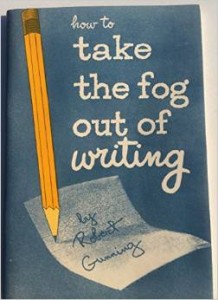| Nov 5, 2015
Writing For Results
One of the best gifts that I ever received was a copy of the book How to Take the Fog Out of Writing by Robert Gunning. At the time, I was just  two years out of college with a tendency for verbosity, $10 dollar words and copy that often well exceeded my allotted word count, much to the dismay of our graphic designers.
two years out of college with a tendency for verbosity, $10 dollar words and copy that often well exceeded my allotted word count, much to the dismay of our graphic designers.
My writing lacked precision; I was indulging my whims as a writer at the expense of my readers.
Two decades later, I’m still a work in progress, but that book transformed the way I wrote and made me a more effective copywriter in far fewer words than I ever thought possible. Sometimes less really is more.
Today, writing clear, concise copy is more critical than ever, thanks to character limits, short attention spans and the limited screen size of our pervasive digital devices.
Fortunately, there are tools to determine if your writing is clear of fog, readable and written at a grade level appropriate for your audience.
The best known are the Gunning FOG Index, the Flesch Reading Ease Score and the Flesch-Kincaid Grade Level Score.
Both the Gunning FOG Index and the Flesch-Kincaid Grade Level Score assess the U.S. grade level that a reader needs to be for comprehension.
According to experts, a score of 7 or 8 is ideal if you are writing for a general audience (think of an insurance company or a consumer products brand). However, reading ability is only part of the equation. Research shows that regardless of level of education, completion, comprehension and retention decline as the grade level of material rises. Why?
Even the most educated among us appreciate plain, easy-to-understand copy that requires less mental work to comprehend. The longer a sentence or paragraph, the longer it takes to reach the point where the words make sense together.
The Flesch Reading Ease Score, considered the most accurate checker and the most widely used (it is even built into Microsoft Office), assesses copy on a 100-point scale based on the speed and ease a reader can get through the material. For most business purposes, a score between 60 and 70 is a good target. A higher score indicates text that is more readable with shorter sentences and fewer multi-syllabic words.
As a frame of reference, Reader’s Digest has a readability index of 65; Time magazine is a 52 and the Harvard Review scores in the low 30s.
So how does your writing measure up? Readability-score.com provides an easy way to plug in copy and evaluate your content using the above-mentioned tools, along with a few others like the Simple Measure of Gobbledygook, otherwise known as the SMOG Index.
According to readability-score.com, here are the stats for this blog.
- Flesch-Kincaid Reading Ease: 60.9
- Flesch-Kincaid Grade Level: 9.4
- Gunning FOG Index: 12.6
If you want to reach more people and improve the retention and comprehension of your ideas, here are a few simple strategies to keep in mind the next time you sit down to write your next sales letter, article, white paper or brochure.
- Write how you speak
- Turn passive sentences into active sentences
- Avoid clichés, hyperbole and buzz words
- Eliminate unnecessary words, including qualifiers
- Avoid long, complex sentences
- Swap out big words when simple words says it better
- Say exactly what you mean
- Aim for a word count
- Use bullets, short paragraphs & graphics
In this information age, content may be king but brevity, clarity and readability rule.
